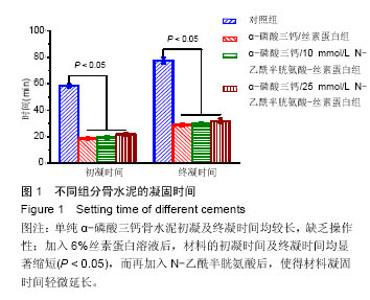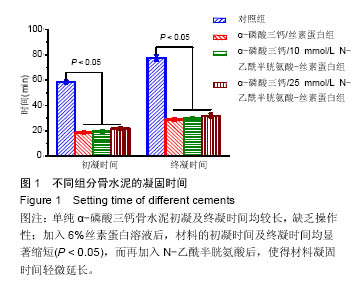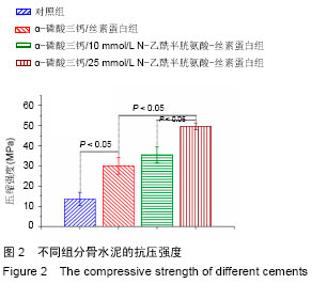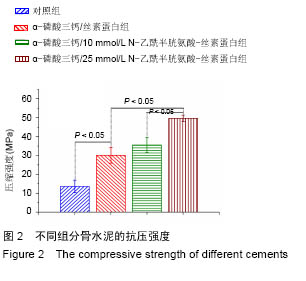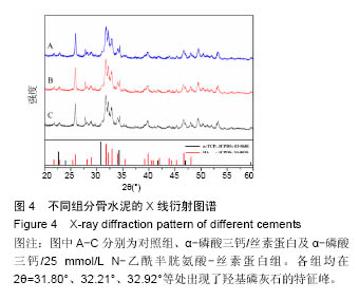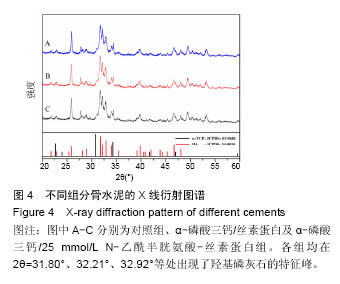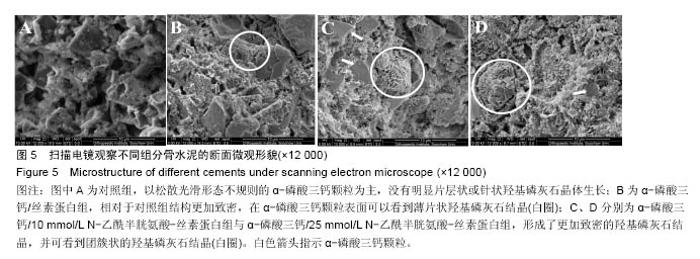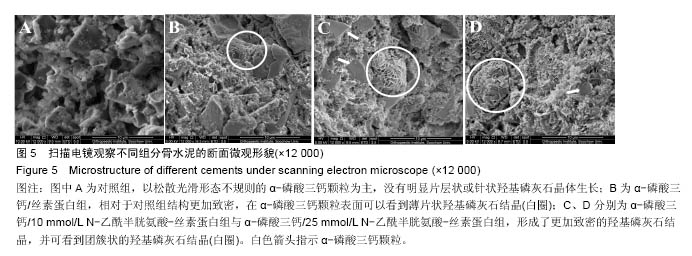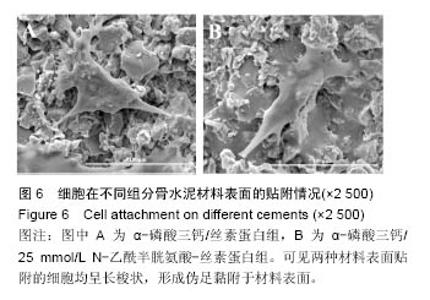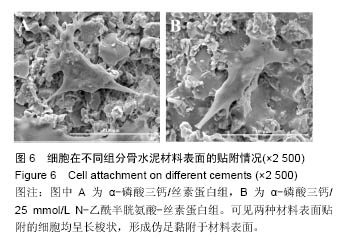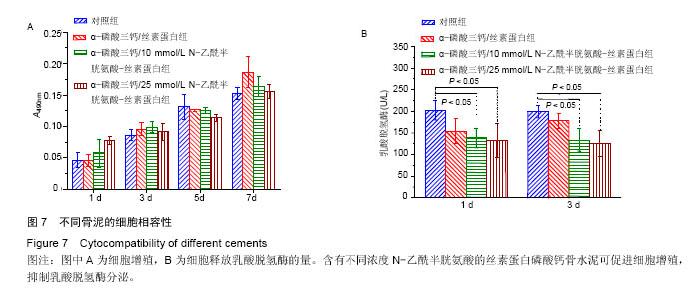Chinese Journal of Tissue Engineering Research ›› 2016, Vol. 20 ›› Issue (52): 7765-7772.doi: 10.3969/j.issn.2095-4344.2016.52.002
Previous Articles Next Articles
Physiochemical properties and cytotoxicity of silk fibroin based calcium phosphate cement incorporated with N-acetylcysteine
- Department of Orthopaedics, the First Affiliated Hospital of Soochow University, Suzhou 215006, Jiangsu Province, China
-
Received:2016-09-26Online:2016-12-16Published:2016-12-16 -
Contact:Zhu Xue-song, Department of Orthopedics, the First Affiliated Hospital of Soochow University, Suzhou 215006, Jiangsu Province, China -
About author:Feng Tao, Master, Physician, Department of Orthopedics, the First Affiliated Hospital of Soochow University, Suzhou 215006, Jiangsu Province, China Pi Bin, M.D., Physician, Department of Orthopedics, the First Affiliated Hospital of Soochow University, Suzhou 215006, Jiangsu Province, China Feng Tao and Pi Bin contributed equally to this work. -
Supported by:the National 863 Program of China, No. 2015AA020316; the National Natural Science Foundation of China, No. 81171689, 81301559; the Natural Science Foundation of Jiangsu Province, No. SBK201341421
CLC Number:
Cite this article
Feng Tao, Pi Bin, Jiang Lei, Li Bin, Lu Ying-jie, Yang Hui-lin, Zhu Xue-song.
share this article
| [1]杨惠林,牛国旗,王根林,等.椎体后凸成形术治疗周壁破损的骨质疏松性椎体骨折[J].中华骨科杂志, 2006,26(3): 165-169.[2]王根林,汪李军,杨惠林,等.椎体后凸成形术治疗骨质疏松性椎体骨折的随访分析[J].苏州大学学报(医学版), 2012, 32(6):865-867.[3]Zhu X,Chen X,Chen C,et al.Evaluation of calcium phosphate and calcium sulfate as injectable bone cements in sheep vertebrae.J Spinal Disord Tech. 2012;25(6):333-337.[4]Gundapaneni D,Goswami T.Thermal isotherms in PMMA and cell necrosis during total hip arthroplasty.J Appl Biomater Funct Mater.2 014;12(3):193-202.[5]Nelson DA,Barker ME,Hamlin BH.Thermal effects of acrylic cementation at bone tumour sites.Int J Hyperthermia.1997;13(3):287-306.[6]Verlaan JJ,Oner FC,Verbout AJ,et al.Temperature elevation after vertebroplasty with polymethyl-methacrylate in the goat spine.J Biomed Mater Res B Appl Biomater. 2003;67(1):581-585.[7]Dorozhkin SV.Self-setting calcium orthophosphate formulations.J Functl Biomaterials.2013;4(4):209-311.[8]Kurashina K,Kurita H,Hirano M,et al.In vivo study of calcium phosphate cements: implantation of an alpha-tricalcium phosphate/dicalcium phosphate dibasic/tetracalcium phosphate monoxide cement paste.Biomaterials.1997;18(7):539-543.[9]Vorndran E,Geffers M,Ewald A,et al.Ready-to-use injectable calcium phosphate bone cement paste as drug carrier.Acta Biomaterialia.2013;9(12):9558-9567.[10]Ito T,Otsuka M.Application of calcium phosphate as a controlled-release device. Biol Pharml Bull. 2013; 36(11):1676-1682.[11]Maenz S,Kunisch E,Muhlstadt M,et al.Enhanced mechanical properties of a novel, injectable, fiber-reinforced brushite cement.J Mech Behav Biomed Mater2014;39:328-338.[12]Kim J,McBride S,Fulmer M,et al.Fiber-reinforced calcium phosphate cement formulations for cranioplasty applications: a 52-week duration preclinical rabbit calvaria study.J Biomed Mater Res B Appl Biomater.2012;100(4):1170-1178.[13]Lai GJ,Shalumon KT,Chen SH,et al.Composite chitosan/silk fibroin nanofibers for modulation of osteogenic differentiation and proliferation of human mesenchymal stem cells.Carbohydr Polym. 2014;111:288-297.[14]Naskar D,Nayak S,Dey T,et al.Non-mulberry silk fibroin influence osteogenesis and osteoblast-macrophage cross talk on titanium based surface.Sci Rep. 2014;4:4745.[15]Cao C,Li H,Li J,et al.Mechanical reinforcement of injectable calcium phosphate cement/silk fibroin (SF) composite by mineralized SF.Ceram Int. 2014;40(9): 13987-13993.[16]Yamada M,Tsukimura N,Ikeda T,et al.N-acetyl cysteine as an osteogenesis-enhancing molecule for bone regeneration.Biomaterials.2013;34(26):6147-6156.[17]Toker H,Ozdemir H,Balci H,et al.N-acetylcysteine decreases alveolar bone loss on experimental periodontitis in streptozotocin-induced diabetic rats.J Periodontal Res.2012;47(6):793-799.[18]Tsukimura N,Yamada M,Aita H,et al.N-acetyl cysteine (NAC)-mediated detoxification and functionalization of poly(methyl methacrylate) bone cement. Biomaterials. 2009;30(20):3378-3389.[19]Franck D,Chung YG,Coburn J,et al.In vitro evaluation of bi-layer silk fibroin scaffolds for gastrointestinal tissue engineering.J Tissue Eng. 2014,5:2041731414556849.[20]Loushine BA,Bryan TE,Looney SW,et al.Setting properties and cytotoxicity evaluation of a premixed bioceramic root canal sealer.J Endod. 2011;37(5):673-677.[21]Yang H,Zou J.Filling materials used in kyphoplasty and vertebroplasty for vertebral compression fracture: a literature review.Artif Cells Blood Substit Immobil Biotechnol.2011;39(2):87-91.[22]Van den Vreken NM,Pieters IY,Declercq HA,et al. Characterization of calcium phosphate cements modified by addition of amorphous calcium phosphate.Acta Biomaterialia.2010;6(2):617-625.[23]Miyamoto Y,Ishikawa K,Takechi M,et al.Basic properties of calcium phosphate cement containing atelocollagen in its liquid or powder phases. Biomaterials. 1998;19(7-9):707-715.[24]李浩.丝素蛋白/羟基磷灰石复合物对磷酸钙骨水泥性能的影响[D].苏州大学,2013.[25]Li X,Lan J,Ai M,et al.Biomineralization on polymer-coated multi-walled carbon nanotubes with different surface functional groups.Colloids Surf B Biointerfaces.2014;123:753-761.[26]Takeo T,Horikoshi Y,Nakao S,et al.Cysteine analogs with a free thiol group promote fertilization by reducing disulfide bonds in the zona pellucida of mice.Biol Reprod. 2015;92(4):90.[27]Sunitha K,Suresh P,Santhosh MS,et al.Inhibition of hyaluronidase by N-acetyl cysteine and glutathione: role of thiol group in hyaluronan protection.Int J Biol Macromol.2013;55:39-46.[28]Barati D,Walters JD,Shariati SR,et al.Effect of organic acids on calcium phosphate nucleation and osteogenic differentiation of human mesenchymal stem cells on peptide functionalized nanofibers.Langmuir. 2015, 31(18):5130-5140.[29]王鹏,皮斌,王金宁,等.壳聚糖微球复合丝素基硫酸钙骨水泥的理化特性[J].中国组织工程研究, 2014,18(12):1831-1838.[30]Thai VV,Lee BT.Fabrication of calcium phosphate-calcium sulfate injectable bone substitute using hydroxy-propyl-methyl-cellulose and citric acid.J Mater Sci Mater Med.2010,21(6):1867-1874.[31]Vlad MD,Gomez S,Barraco M,et al.Effect of the calcium to phosphorus ratio on the setting properties of calcium phosphate bone cements.J Mater Sci Mater Med.2012;23(9):2081-2090.[32]Krebs J,Aebli N,Goss BG,et al.Cardiovascular changes after pulmonary embolism from injecting calcium phosphate cement.J Biomed Mater Res B Appl Biomater. 2007;82(2):526-532.[33]Pioletti DP,Takei H,Lin T,et al.The effects of calcium phosphate cement particles on osteoblast functions. Biomaterials.2000;21(11):1103-1114. |
| [1] | Zhang Tongtong, Wang Zhonghua, Wen Jie, Song Yuxin, Liu Lin. Application of three-dimensional printing model in surgical resection and reconstruction of cervical tumor [J]. Chinese Journal of Tissue Engineering Research, 2021, 25(9): 1335-1339. |
| [2] | Zeng Yanhua, Hao Yanlei. In vitro culture and purification of Schwann cells: a systematic review [J]. Chinese Journal of Tissue Engineering Research, 2021, 25(7): 1135-1141. |
| [3] | Xu Dongzi, Zhang Ting, Ouyang Zhaolian. The global competitive situation of cardiac tissue engineering based on patent analysis [J]. Chinese Journal of Tissue Engineering Research, 2021, 25(5): 807-812. |
| [4] | Wu Zijian, Hu Zhaoduan, Xie Youqiong, Wang Feng, Li Jia, Li Bocun, Cai Guowei, Peng Rui. Three-dimensional printing technology and bone tissue engineering research: literature metrology and visual analysis of research hotspots [J]. Chinese Journal of Tissue Engineering Research, 2021, 25(4): 564-569. |
| [5] | Chang Wenliao, Zhao Jie, Sun Xiaoliang, Wang Kun, Wu Guofeng, Zhou Jian, Li Shuxiang, Sun Han. Material selection, theoretical design and biomimetic function of artificial periosteum [J]. Chinese Journal of Tissue Engineering Research, 2021, 25(4): 600-606. |
| [6] | Liu Fei, Cui Yutao, Liu He. Advantages and problems of local antibiotic delivery system in the treatment of osteomyelitis [J]. Chinese Journal of Tissue Engineering Research, 2021, 25(4): 614-620. |
| [7] | Li Xiaozhuang, Duan Hao, Wang Weizhou, Tang Zhihong, Wang Yanghao, He Fei. Application of bone tissue engineering materials in the treatment of bone defect diseases in vivo [J]. Chinese Journal of Tissue Engineering Research, 2021, 25(4): 626-631. |
| [8] | Zhang Zhenkun, Li Zhe, Li Ya, Wang Yingying, Wang Yaping, Zhou Xinkui, Ma Shanshan, Guan Fangxia. Application of alginate based hydrogels/dressings in wound healing: sustained, dynamic and sequential release [J]. Chinese Journal of Tissue Engineering Research, 2021, 25(4): 638-643. |
| [9] | Chen Jiana, Qiu Yanling, Nie Minhai, Liu Xuqian. Tissue engineering scaffolds in repairing oral and maxillofacial soft tissue defects [J]. Chinese Journal of Tissue Engineering Research, 2021, 25(4): 644-650. |
| [10] | Xing Hao, Zhang Yonghong, Wang Dong. Advantages and disadvantages of repairing large-segment bone defect [J]. Chinese Journal of Tissue Engineering Research, 2021, 25(3): 426-430. |
| [11] | Chen Siqi, Xian Debin, Xu Rongsheng, Qin Zhongjie, Zhang Lei, Xia Delin. Effects of bone marrow mesenchymal stem cells and human umbilical vein endothelial cells combined with hydroxyapatite-tricalcium phosphate scaffolds on early angiogenesis in skull defect repair in rats [J]. Chinese Journal of Tissue Engineering Research, 2021, 25(22): 3458-3465. |
| [12] | Wang Hao, Chen Mingxue, Li Junkang, Luo Xujiang, Peng Liqing, Li Huo, Huang Bo, Tian Guangzhao, Liu Shuyun, Sui Xiang, Huang Jingxiang, Guo Quanyi, Lu Xiaobo. Decellularized porcine skin matrix for tissue-engineered meniscus scaffold [J]. Chinese Journal of Tissue Engineering Research, 2021, 25(22): 3473-3478. |
| [13] | Mo Jianling, He Shaoru, Feng Bowen, Jian Minqiao, Zhang Xiaohui, Liu Caisheng, Liang Yijing, Liu Yumei, Chen Liang, Zhou Haiyu, Liu Yanhui. Forming prevascularized cell sheets and the expression of angiogenesis-related factors [J]. Chinese Journal of Tissue Engineering Research, 2021, 25(22): 3479-3486. |
| [14] | Liu Chang, Li Datong, Liu Yuan, Kong Lingbo, Guo Rui, Yang Lixue, Hao Dingjun, He Baorong. Poor efficacy after vertebral augmentation surgery of acute symptomatic thoracolumbar osteoporotic compression fracture: relationship with bone cement, bone mineral density, and adjacent fractures [J]. Chinese Journal of Tissue Engineering Research, 2021, 25(22): 3510-3516. |
| [15] | Liu Liyong, Zhou Lei. Research and development status and development trend of hydrogel in tissue engineering based on patent information [J]. Chinese Journal of Tissue Engineering Research, 2021, 25(22): 3527-3533. |
| Viewed | ||||||
|
Full text |
|
|||||
|
Abstract |
|
|||||
